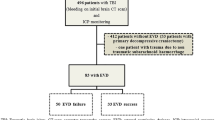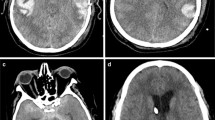Abstract
Introduction
There is clinical equipoise regarding whether neurointensive care unit management of external ventricular drains (EVD) in severe traumatic brain injury (TBI) should involve an open EVD, with continuous drainage of cerebrospinal fluid (CSF), versus a closed EVD, with intermittent opening as necessary to drain CSF. In a matched cohort design, we assessed the relative impact of continuous versus intermittent CSF drainage on intracranial pressure in the management of adult severe TBI.
Methods
Sixty-two severe TBI patients were assessed. Thirty-one patients managed by open EVD drainage were matched by age, sex, and injury severity (initial Glasgow Coma Scale (GCS) score) to 31 patients treated with a closed EVD drainage. Patients in the open EVD group also had a parenchymal intracranial pressure (ICP) monitor placed through an adjacent burr hole, allowing real-time recording of ICP. Hourly ICP and other pertinent data, such as length of stay in intensive care unit (LOS-ICU), Injury Severity Score, and survival status, were extracted from our prospective database.
Results
With age, injury severity (initial GCS score), and neurosurgical intervention adjusted for, there was a statistically significant difference of 5.66 mmHg in mean ICP (p < 0.0001) between the open and the closed EVD groups, with the closed EVD group exhibiting greater mean ICP. ICP burden (ICP ≥ 20 mmHg) was shown to be significantly higher in the intermittent EVD group (p = 0.0002) in comparison with the continuous EVD group.
Conclusion
Continuous CSF drainage via an open EVD seemed to be associated with more effective ICP control in the management of adult severe TBI.

Similar content being viewed by others
References
Dash PK, Zhao J, Hergenroeder G, Moore AN. Biomarkers for the diagnosis, prognosis, and evaluation of treatment efficacy for traumatic brain injury. Neurotherapeutics. 2010;7(1):100–14.
Exo J, Kochanek PM, Adelson PD, et al. Intracranial pressure-monitoring systems in children with traumatic brain injury: combining therapeutic and diagnostic tools. Pediatr Crit Care Med. 2011;12(5):560–7.
Gigante P, Hwang BY, Appelboom G, et al. External ventricular drainage following aneurysmal subarachnoid haemorrhage. Br J Neurosurg. 2010;24(6):625–32.
Jagannathan J, Okonkwo DO, Yeoh H, et al. Long-term outcomes and prognostic factors in pediatric patients with severe traumatic brain injury and elevated intracranial pressure. J Neurosurg Pediatr. 2008;2:240–9.
Kahraman S, Dutton RP, Hu P, et al. Automated measurement of “pressure times time dose” of intracranial hypertension best predicts outcome after severe traumatic brain injury. J Trauma. 2010;69(1):110–8.
Kim GS, Amato A, James ML, et al. Continuous and intermittent CSF diversion after subarachnoid hemorrhage: a pilot study. Neurocrit Care. 2011;14:68–72.
Mehta A, Kochanek PM, Tyler-Kabara E, et al. Relationship of intracranial pressure and cerebral perfusion pressure with outcome in young children after severe traumatic brain injury. Dev Neurosci. 2010;32:413–9.
Ngo Q, Ranger A, Singh RN, Kornecki A, Seabrook JA, Fraser DD. External ventricular drains in pediatric patients. Pediatr Crit Care Med. 2009;10(3):346–51.
Paul Shore, Thomas NJ, Clark RS, et al. Continuous versus intermittent cerebrospinal fluid drainage after severe traumatic brain injury in children: effect on biochemical markers. J Neurotrauma. 2004;21(9):1113–22.
Paul Shore, Jackson EK, Wisniewski SR, Clark RS, Adelson PD, Kochanek PM. Vascular endothelial growth factor is increased in cerebrospinal fluid after traumatic brain injury in infants and children. Neurosurgery. 2004;54(3):605–11.
Vender J, Waller J, Dhandapani K, McDonnell D. An evaluation and comparison of intraventricular, intraparenchymal, and fluid-coupled techniques for intracranial pressure monitoring in patients with severe traumatic brain injury. J Clin Monit Comput. 2011;25(4):231–6.
Acknowledgment
Mr. Nwachuku was supported by the National Institute of Mental Health (2R25MH054318) and the Brain Trauma Research Center was supported by the National Institute of Neurological Disorders and Stroke (P01 NS030318).
Conflict of interest
All authors involved declare that they have no conflict of interest in regard to any resources used for the study.
Author information
Authors and Affiliations
Corresponding author
Rights and permissions
About this article
Cite this article
Nwachuku, E.L., Puccio, A.M., Fetzick, A. et al. Intermittent Versus Continuous Cerebrospinal Fluid Drainage Management in Adult Severe Traumatic Brain Injury: Assessment of Intracranial Pressure Burden. Neurocrit Care 20, 49–53 (2014). https://doi.org/10.1007/s12028-013-9885-3
Published:
Issue Date:
DOI: https://doi.org/10.1007/s12028-013-9885-3




